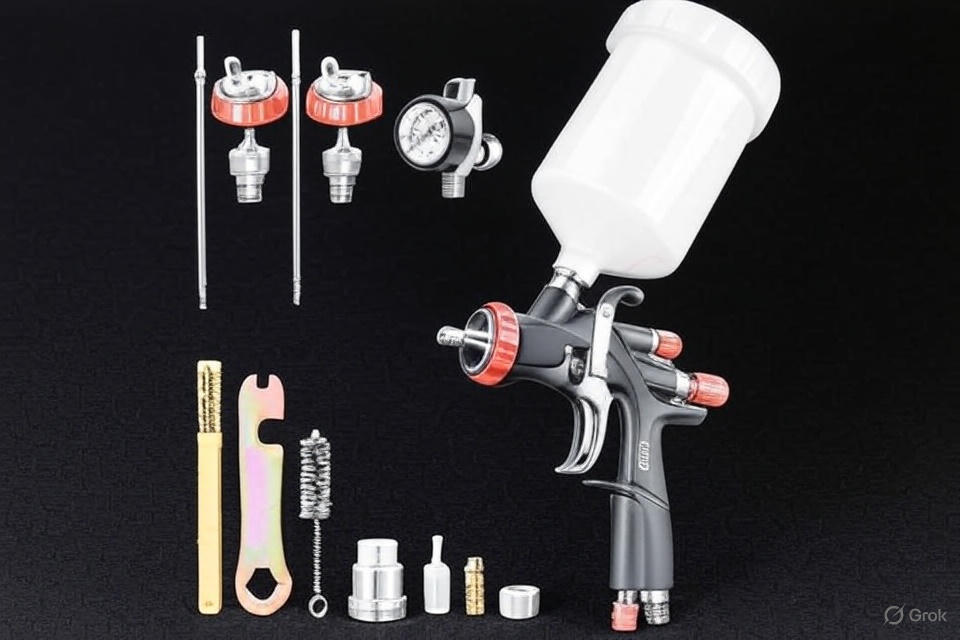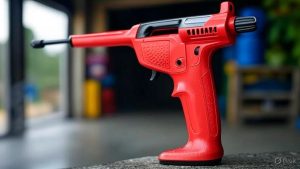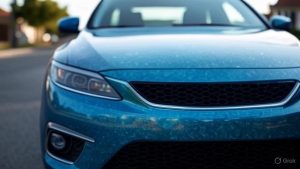Starting your automotive painting journey requires the right equipment, and a quality paint gun serves as the foundation of any successful project. Beginners often feel overwhelmed by the numerous options available in the market today. This comprehensive review examines five exceptional automotive paint guns that deliver professional results while remaining accessible to newcomers.
The world of automotive painting has evolved dramatically, with modern spray guns offering precision and reliability that was once reserved for professional body shops. These tools now feature user-friendly designs that help beginners achieve smooth, even coats without the steep learning curve traditionally associated with spray painting.
Understanding Paint Gun Technologies
Before diving into specific product reviews, beginners must grasp the fundamental differences between HVLP and LVLP technologies. High Volume Low Pressure (HVLP) systems use large amounts of air at low pressure to atomize paint, resulting in less overspray and better transfer efficiency. Low Volume Low Pressure (LVLP) systems require even less air volume while maintaining excellent atomization quality.
Both technologies offer distinct advantages for different applications and skill levels. HVLP guns typically provide better coverage for larger surfaces, while LVLP guns offer more precise control for detailed work. The choice between these systems often depends on your specific project requirements and available air compressor capacity.
Top 5 Automotive Paint Guns for Beginners
1. HVLP Air Spray Gun with Multiple Nozzles and Accessories
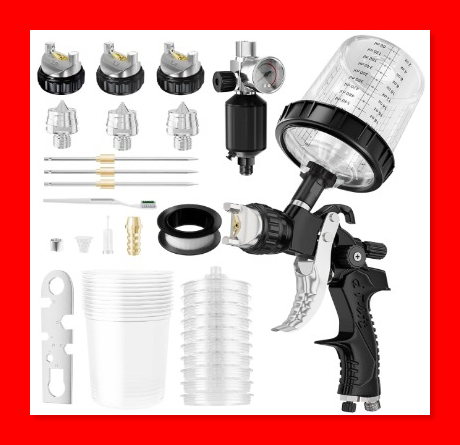
This comprehensive HVLP spray gun kit stands out as an exceptional choice for beginners who want versatility and value. The package includes three different nozzle sizes (1.4mm, 1.7mm, and 2mm), allowing users to handle various paint viscosities and project types. The included air compressor regulator ensures consistent pressure control, which is crucial for achieving professional results.
The gravity-feed design reduces fatigue during extended use, while the 600cc mixing cups with lids provide convenient paint storage and mixing capabilities. Ten cups come with the kit, ensuring you have enough supplies for multiple projects or color changes. The ergonomic handle design minimizes hand strain, making it comfortable for beginners who might need extra time to complete their work.
Key Features:
- Three interchangeable nozzles for different applications
- Air compressor regulator for precise pressure control
- Ten 600cc mixing cups with secure lids
- Gravity-feed design for reduced user fatigue
- Suitable for automotive, house, and furniture painting
The spray pattern adjustment allows users to switch between horizontal, vertical, and circular patterns, providing flexibility for different surface orientations. The brass construction of internal components ensures durability and longevity, while the stainless steel nozzles resist corrosion and maintain consistent spray quality over time.
Beginners will appreciate the detailed instruction manual that explains proper setup, paint mixing ratios, and cleaning procedures. The kit’s comprehensive nature means you won’t need to purchase additional accessories immediately, making it an economical choice for those starting their painting journey.
2. InoKraft D1 LVLP Air Spray Gun Premium Kit
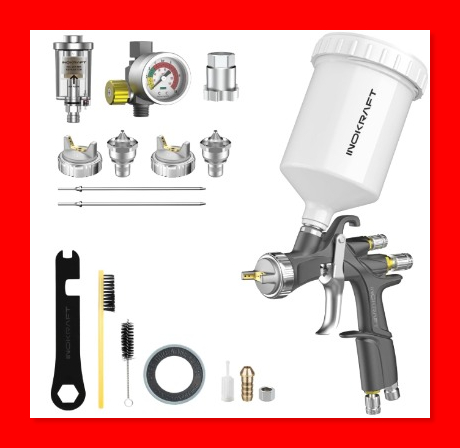
The InoKraft D1 represents the pinnacle of user-friendly design in LVLP spray gun technology. This premium kit focuses on simplicity without sacrificing performance, making it an ideal choice for beginners who want professional results from their first project. The LVLP technology requires less air volume than traditional HVLP systems, making it compatible with smaller air compressors that many home users already own.
Three precision-machined nozzles (1.3mm, 1.5mm, and 1.7mm) provide excellent versatility for different paint types and application techniques. The 1.3mm nozzle excels with thin base coats and clear coats, while the 1.7mm option handles primer and thicker paints effectively. The intermediate 1.5mm nozzle offers balanced performance for most automotive painting tasks.
The lightweight aluminum body reduces user fatigue during extended painting sessions, while the ergonomic grip design provides comfortable control. The precision-engineered air cap ensures consistent atomization across all spray patterns, resulting in smooth, even finishes that rival professional work.
Key Features:
- LVLP technology requires minimal air volume
- Three precision nozzles for various applications
- Lightweight aluminum construction
- Ergonomic design for comfortable use
- Includes comprehensive accessory kit
The included accessories package contains cleaning brushes, extra gaskets, and a detailed maintenance guide. This attention to long-term care helps beginners maintain their equipment properly, ensuring consistent performance over many projects. The quick-release cup system allows for rapid color changes, which is particularly valuable when working on multi-color projects.
The spray gun’s forgiving nature makes it perfect for beginners who are still developing their technique. Even slight variations in distance or speed don’t result in dramatic finish quality changes, giving new users confidence as they learn proper spraying techniques.
3. AEROPRO TOOLS R500 LVLP Air Spray Gun
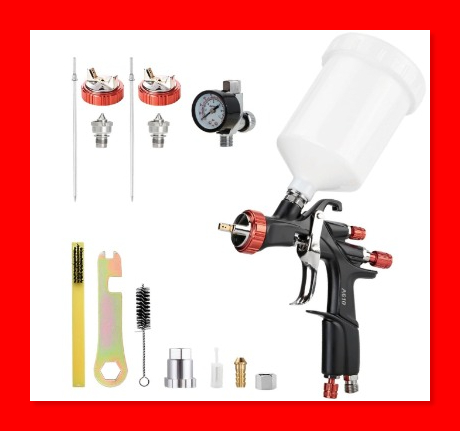
The AEROPRO TOOLS R500 combines professional-grade construction with beginner-friendly features, creating an exceptional tool for automotive painting enthusiasts. This LVLP spray gun delivers outstanding atomization quality while requiring minimal air volume, making it suitable for most home workshop air compressor setups.
The included air regulator provides precise pressure control directly at the gun, eliminating the guesswork often associated with spray gun setup. Three high-quality nozzles (1.3mm, 1.5mm, and 1.7mm) handle everything from fine detail work to full panel coverage. The precision-machined components ensure consistent spray patterns and reliable performance project after project.
The gun’s balanced weight distribution reduces hand fatigue, while the smooth trigger action provides excellent control over paint flow. The large, easy-to-read pressure gauge helps beginners monitor and maintain optimal operating conditions throughout their painting session.
Key Features:
- Built-in air regulator with precise pressure gauge
- Three professional-grade nozzles included
- Balanced weight distribution for comfortable use
- High-quality construction with precision components
- Suitable for automotive, furniture, and architectural applications
The anodized aluminum finish resists corrosion and maintains its appearance even after extensive use. The gun disassembles easily for thorough cleaning, with clearly marked components that make reassembly straightforward for beginners. The included cleaning kit contains all necessary tools and supplies for proper maintenance.
Users consistently praise this spray gun’s consistency and reliability. The forgiving spray characteristics help beginners achieve professional-looking results while they develop their technique. The comprehensive instruction manual includes troubleshooting guides and technique tips that prove invaluable for new users.
4. Professional HVLP Spray Gun Set with Gravity Feed Design
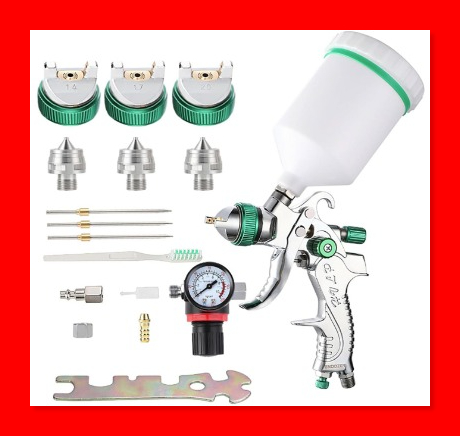
This professional-grade HVLP spray gun set delivers exceptional value for beginners who want to invest in quality equipment from the start. The gravity-feed design ensures consistent paint flow and reduces waste, while the included pressure gauge provides precise monitoring of operating conditions.
Three nozzle sizes (1.4mm, 1.7mm, and 2.0mm) cover the full range of automotive painting applications. The 1.4mm nozzle excels with base coats and metallic paints, the 1.7mm handles most general applications, and the 2.0mm tackles primers and high-build materials effectively. The 20oz (600cc) cup provides ample capacity for most projects while remaining manageable for beginners.
The precision-machined brass components ensure durability and consistent performance. The stainless steel nozzles resist corrosion and maintain their precision over time, making this an investment that will serve beginners well as they advance their skills.
Key Features:
- Professional-grade HVLP technology
- Gravity-feed design with 20oz capacity cup
- Three precision nozzles for complete versatility
- Built-in pressure gauge for accurate monitoring
- High-quality brass and stainless steel construction
The ergonomic handle design provides comfortable grip during extended use, while the balanced weight distribution reduces fatigue. The smooth trigger action offers precise control over paint flow, allowing beginners to develop proper technique gradually.
This spray gun excels with automotive paints, primers, and clear coats but specifically excludes latex paints due to their unique properties. The manufacturer provides clear guidance on compatible paint types, helping beginners avoid common mistakes that could damage their equipment or compromise their results.
The comprehensive accessory package includes cleaning supplies, spare parts, and a detailed maintenance schedule. This attention to long-term care helps beginners establish good maintenance habits that will extend their equipment’s life and ensure consistent performance.
5. HVLP 6800B Spray Gun with Specialized Features
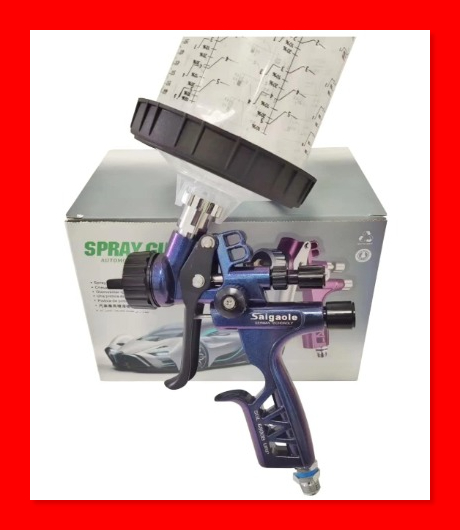
The HVLP 6800B represents a unique approach to beginner-friendly spray gun design. The 1.3mm nozzle size makes it particularly well-suited for detail work and finish coats, while the low-pressure operation (260L/min) ensures compatibility with most air compressor systems found in home workshops.
The distinctive blue finish not only looks professional but also helps identify the tool quickly in a busy workshop environment. The no-wash cup design simplifies setup and reduces preparation time, allowing beginners to focus on developing their spraying technique rather than dealing with complex equipment preparation.
The lightweight construction reduces user fatigue, particularly important for beginners who may take longer to complete their projects as they learn proper technique. The precision-engineered air cap provides excellent atomization quality, ensuring smooth, even finishes even at the relatively low operating pressure.
Key Features:
- Specialized 1.3mm nozzle for precision work
- Low-pressure operation at 260L/min
- No-wash cup design for simplified setup
- Lightweight construction reduces fatigue
- Distinctive blue finish for easy identification
The spray gun’s forgiving nature makes it an excellent choice for beginners who are still developing their technique. Small variations in spray distance or gun speed don’t dramatically affect finish quality, giving new users confidence as they practice.
The included adapter ensures compatibility with standard air compressor fittings, eliminating potential connection issues that might frustrate beginners. The straightforward design means fewer parts to clean and maintain, simplifying the overall ownership experience.
Users appreciate this spray gun’s consistency and predictable behavior. The single nozzle size eliminates confusion about which tip to use for different applications, while still providing excellent results with most automotive paint systems.
Essential Factors for Beginners
Starting with automotive painting requires careful consideration of several key factors that directly impact your success and satisfaction. Paint gun selection represents just one piece of the puzzle, but it’s a crucial foundation that affects every subsequent step in your painting process.
Air Compressor Compatibility
Your air compressor’s capacity determines which spray guns will work effectively in your workshop. HVLP systems typically require 10-15 CFM at 40 PSI, while LVLP systems often operate efficiently with 5-8 CFM at 20-25 PSI. Beginners should verify their compressor specifications before purchasing a spray gun to avoid performance issues and frustration.
Tank size also plays a crucial role in spray gun performance. Smaller tanks (20-30 gallons) may struggle to maintain consistent pressure during extended spraying sessions, leading to uneven finishes and frequent pauses for pressure recovery. Larger tanks (60+ gallons) provide more consistent performance but require more space and initial investment.
Paint Types and Viscosity
Different automotive paints require specific spray gun setups for optimal results. Base coats typically work best with smaller nozzles (1.3-1.4mm), while primers may require larger openings (1.8-2.0mm) to handle their thicker consistency. Clear coats fall somewhere in between, often working well with 1.5-1.7mm nozzles.
Understanding paint viscosity helps beginners achieve consistent results across different products. Thinning ratios vary between paint brands and types, but most automotive paints require some degree of reduction for proper spray gun atomization. Following manufacturer guidelines ensures optimal flow characteristics and finish quality.
Workshop Environment and Setup
Proper ventilation is non-negotiable when spray painting, both for safety and finish quality. Air movement helps carry away overspray and solvent vapors while preventing dust and debris from settling on wet paint. Beginners should invest in appropriate ventilation equipment before attempting any spray painting projects.
Temperature and humidity significantly affect paint behavior and final finish quality. Most automotive paints perform best in temperatures between 65-75°F with relative humidity below 50%. Higher humidity can cause paint to blush or develop surface defects, while extreme temperatures affect flow characteristics and drying times.
Maintenance and Care Guidelines
Proper maintenance extends spray gun life and ensures consistent performance across multiple projects. Beginners who establish good maintenance habits from the start will save money on repairs and replacements while achieving better results with every use.
Daily Cleaning Procedures
Thorough cleaning after each use prevents paint buildup that can clog passages and affect spray patterns. Disassemble the spray gun according to manufacturer instructions, paying particular attention to the nozzle, needle, and air cap components. These precision parts require gentle handling to maintain their accuracy.
Use appropriate cleaning solvents that match your paint system. Lacquer thinners work well for most automotive paints, while water-based systems require specialized cleaners. Avoid harsh solvents that might damage seals and gaskets, leading to air leaks and performance issues.
Long-term Storage Considerations
Extended storage requires additional preparation to prevent internal corrosion and seal deterioration. Light machine oil applied to moving parts helps prevent rust and keeps mechanisms operating smoothly. Remove all paint residue and apply a thin coat of protective oil to metal surfaces.
Store spray guns in clean, dry environments away from temperature extremes. Many manufacturers provide protective cases that shield components from dust and accidental damage. Proper storage practices ensure your spray gun remains ready for immediate use when your next project begins.
Troubleshooting Common Issues
Beginners often encounter similar problems as they develop their spray painting skills. Uneven spray patterns usually result from clogged air passages or damaged nozzles. Regular cleaning prevents most issues, while careful handling protects precision components from damage.
Paint spitting typically indicates contamination in the paint system or improper thinning ratios. Strain paint through fine mesh filters and follow manufacturer mixing guidelines to prevent these issues. Consistent spray gun setup and paint preparation eliminate most common problems that frustrate beginners.
Safety Considerations for Beginners
Spray painting involves several safety hazards that beginners must understand and address before beginning any project. Proper safety equipment and procedures protect both immediate health and long-term well-being while ensuring optimal working conditions for quality results.
Personal Protective Equipment
Respiratory protection represents the most critical safety consideration when spray painting. Paint particles and solvent vapors can cause both immediate irritation and long-term health problems. Beginners should invest in properly fitted respirators with appropriate filters for their specific paint systems.
Eye protection prevents paint particles and overspray from causing irritation or injury. Safety glasses or face shields provide adequate protection while maintaining clear vision during detailed work. Disposable coveralls protect skin and clothing from paint contamination while reducing cleanup time.
Ventilation Requirements
Adequate ventilation removes dangerous vapors while providing the air movement necessary for quality finishes. Cross-flow ventilation works best, with fresh air entering from one side of the work area and contaminated air exhausted from the opposite side. This arrangement prevents vapor accumulation while maintaining consistent air quality.
Explosion-proof fans and lighting prevent ignition sources in areas where flammable vapors may accumulate. Standard electrical equipment can create sparks that ignite solvent vapors, leading to serious accidents. Professional-grade ventilation equipment includes these safety features as standard components.
Fire Prevention Measures
Flammable solvents require careful handling and storage to prevent fires and explosions. Keep containers tightly sealed when not in use, and store them away from heat sources and ignition points. Fire extinguishers rated for flammable liquids should be readily accessible in all spray painting areas.
Static electricity buildup during paint transfer can create ignition sources. Ground all containers and equipment according to manufacturer instructions, and use conductive flooring materials where appropriate. These precautions prevent static discharge that could ignite paint vapors.
Technique Development for Beginners
Mastering spray gun technique requires practice and patience, but beginners can accelerate their learning by focusing on fundamental principles that apply to all spray painting applications. Consistent practice with proper form builds muscle memory that leads to professional-quality results.
Proper Gun Movement and Distance
Maintaining consistent distance from the surface ensures even paint coverage and proper atomization. Most spray guns work best at 6-8 inches from the surface, though specific distances vary with gun type and paint system. Practice maintaining this distance while moving the gun in smooth, overlapping passes.
Gun movement should remain perpendicular to the surface throughout each pass. Arcing motions create uneven coverage with heavy buildup in the center and light coverage at the edges. Straight, parallel passes with 50% overlap ensure uniform paint distribution and smooth finishes.
Trigger Control and Paint Flow
Proper trigger technique involves separate control of air and paint flow. Begin each pass with the trigger partially depressed to establish air flow, then gradually increase paint flow as you move across the surface. This technique prevents heavy paint buildup at the beginning of each pass.
Release paint flow before stopping gun movement at the end of each pass. This prevents heavy paint accumulation that creates runs and sags. Consistent trigger control becomes second nature with practice, leading to smooth, even finishes across entire panels.
Pattern Development and Coverage
Spray pattern adjustment allows customization for different surface shapes and sizes. Vertical patterns work best for horizontal surfaces, while horizontal patterns suit vertical panels. Circular patterns provide excellent coverage for detailed areas and curved surfaces.
Overlap adjacent passes by approximately 50% to ensure complete coverage without excessive buildup. Consistent overlap patterns create uniform finishes without streaks or variations in gloss level. Practice these patterns on test surfaces before attempting final paint application.
Cost Considerations and Value Analysis
Budget planning for spray gun purchases involves more than initial equipment costs. Long-term ownership expenses include maintenance supplies, replacement parts, and consumables that add up over time. Beginners should consider total cost of ownership when comparing different spray gun options.
Initial Investment Requirements
Quality spray guns represent significant initial investments, but they provide better results and longer service life compared to budget alternatives. Professional-grade equipment typically costs more upfront but delivers consistent performance that justifies the expense through better finishes and reduced material waste.
Complete starter kits offer better value than purchasing individual components separately. These packages include essential accessories and supplies that would otherwise require separate purchases. Manufacturers often provide package discounts that make professional-quality equipment more accessible to beginners.
Operating Costs and Consumables
Replacement nozzles, needles, and seals represent ongoing expenses that vary with usage frequency and maintenance quality. Quality components last longer with proper care, reducing long-term operating costs. Beginners should factor these expenses into their budget planning.
Paint consumption varies significantly between different spray gun designs and user technique levels. Efficient guns with good transfer efficiency waste less paint through overspray, reducing material costs over time. Beginning users typically waste more paint while learning proper technique, but this improves rapidly with practice.
Long-term Value Proposition
Quality spray guns maintain their performance characteristics over many projects, providing consistent value throughout their service life. Cheaper alternatives may seem attractive initially but often require more frequent replacement and deliver inconsistent results that waste time and materials.
Resale value considerations apply to high-quality spray guns that retain significant worth even after extensive use. Professional-grade equipment from respected manufacturers holds value well, making it easier to upgrade or change systems as skills develop and needs evolve.
Conclusion and Final Recommendations
The journey into automotive painting begins with selecting the right spray gun for your skill level and project requirements. Each of the reviewed options offers unique advantages that cater to different beginner needs and preferences. Success depends on matching equipment capabilities with your specific situation and commitment to learning proper techniques.
The HVLP Air Spray Gun with multiple nozzles provides exceptional versatility and value for beginners who want comprehensive capabilities from their first purchase. The complete accessory package eliminates the need for additional purchases while providing everything necessary for professional-quality results.
The InoKraft D1 LVLP system excels for users with smaller air compressors or those who prefer the precision control that LVLP technology provides. The premium construction and user-friendly design make it an excellent choice for beginners who want to invest in quality equipment from the start.
The AEROPRO TOOLS R500 offers professional-grade performance with features that help beginners achieve consistent results. The built-in pressure regulation and comprehensive accessory package provide excellent value for serious hobbyists.
The Professional HVLP Spray Gun Set delivers traditional HVLP performance with modern convenience features. The gravity-feed design and precision components make it suitable for beginners who plan to tackle a variety of automotive painting projects.
The HVLP 6800B provides specialized capabilities for detail work and finish applications. The simplified design and forgiving performance characteristics make it perfect for beginners who want to focus on developing technique without complex equipment management.
Success in automotive painting requires patience, practice, and proper equipment. Any of these spray guns will serve beginners well, but the best choice depends on your specific needs, budget, and long-term goals. Start with quality equipment, invest time in learning proper techniques, and maintain your tools carefully for the best results and longest service life.
Remember that spray gun selection represents just the beginning of your automotive painting journey. Proper setup, technique development, and safety practices all contribute equally to final results. Take time to learn each aspect thoroughly, and don’t hesitate to seek guidance from experienced painters or professional training resources.
The investment in quality spray gun equipment pays dividends through better results, reduced material waste, and increased satisfaction with your automotive painting projects. Choose the option that best matches your current needs while providing room for growth as your skills develop and projects become more ambitious.

